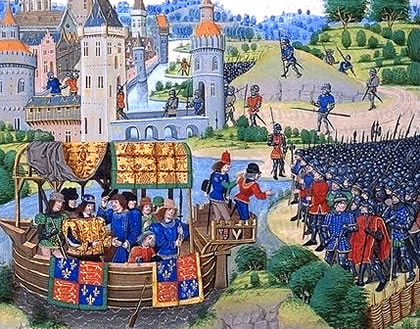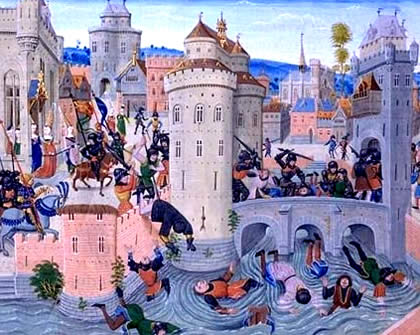 |
| Richard II meets the rebels |
In the early summer of 1381 a series of protests and revolts erupted across England. Peasants and townspeople rose against royal agents in opposition to a poll tax the royal government had levied upon them.
While the poll tax was the immediate cause of the rebellion, it was the focal point for a litany of complaints about the economic oppression the landholders and government had forced upon working people since the Black Death.
In the three decades following the Black Death landlords and peasants struggled over customary obligations and duties. The plague created a labor shortage and an increased availability of land, and many peasants saw an opportunity for economic gain, but the landholders saw the potential for their own economic ruin.
 |
The lords attempted to solve the duduk perkara using legal means, establishing laws such as the Statute of Laborers (1351), which fixed all wages at the levels of 1346, before the plague. Peasants who profited from higher wages received fines.
Enforcement proved difficult since manorial lords, lesser gentry, wealthy peasants, and towns all competed for the smaller labor supply, but attempts to enforce the law nevertheless occurred, making lawyers and government officials the objects of resentment while driving rural village leaders and urban labor leaders into alliance. A collapse in grain prices in the mid-1370s intensified the economic tension.
To compound the commoners’ tax burden, the Crown’s extended military campaigns had proved extremely costly. To pay off debt from previous adventures, as well as to fund new military activity in France, in 1371 the Crown undertook a aktivitas of increasingly intense taxation.
Labor laws and landlords attempting to revive their manorial rights never provoked anything beyond local protest and passive resistance, but new taxes introduced in 1371 differed remarkably from traditional forms of taxation.
The taxes on parishes of 1371 and the poll taxes of 1377, 1379, and 1381 taxed people rather than possessions or land, and they hit hardest in the populous areas of East Anglia.
 |
| Peasant Leader |
With taxation at an all-time high in 1381, the Crown levied a poll tax to raise £66,666 for the duke of Buckingham’s campaign in Brittany. The tax was three times what it had been in 1377. However the collectors’s preliminary returns indicated a nationwide shortfall in revenue. One-third of the people who paid the tax in 1377 were missing—nearly half a million taxpayers.
Faced with a potential shortfall of one-third of its poll tax revenue, the government ordered the tax assessors back into the field and appointed commissions composed of local landholders and lawyers to investigate instances of evasion and collect delinquent taxes.
On May 30 an angry group of men, insisting that they had already paid their taxes, attacked two tax commissioners at Brentwood. The commissioners fled, and villagers, fearing government retribution, banded together with men from nearby villages. On June 2 they gathered at Bocking, swearing to destroy the king’s agents, his laws, all forms of lordship, and to live only by their own laws.
The protestors sent word to Kent, where another rising had occurred, appealing for support. The rising spread to central Essex, where rebels murdered the escheator and destroyed the houses of Sir Robert Hales, the king’s treasurer, and Sir John Sewale, the sheriff.
Rebels burned the sheriff’s financial records in Chelmsford on June 11, and throughout the county peasants burned manorial records, destroying proof of their landlords’ claims over them. The peasants directed most of their violence against records rather than landholders, but some died, mostly sheriffs, justices, and tax collectors who represented the Crown and the magistracy.
The rebels vowed to destroy the institution of lordship yet fully supported their 14-year-old king, Richard II (1377–99), who nevertheless was wary. On June 11 he rode to the Tower of London with his bodyguard and the earls of Salisbury, Warwick, and Oxford.
His mother; his chancellor, Archbishop Sudbury; his treasurer, Hales; and William Walworth, mayor of London, also retreated to the Tower for protection. The next day the bands from Essex converged at Mile End and those from Kent met at Blackheath.
Several leaders emerged, including Wat Tyler and Jack Straw. Richard sailed down the Thames to Greenwich to meet the rebels but with no way to ensure the king’s safety, Richard’s party concluded that landing would be too hazardous.
On Thursday morning, June 13, the mob arrived at the gates of London, and the city admitted them. The exact number of rebels that day is unknown. Once inside the gates, they released prisoners from the Fleet, Newgate, and the Marshalsea; burned the Savoy palace owned by the king’s uncle; and murdered foreigners, notably the Flemish and Italians.
The royal party soon realized it was trapped. Though safe in the impregnable Tower, they were too few in number to break out. Their only hope was negotiation. The king agreed to meet the rebels on June 14 at Mile End.
Friday morning Richard and his bodyguard of lords and knights rode out to talk with the mob. The king had to grant pardons and give charters of freedom to the rebels. Furthermore they demanded abolition of serfdom, rent of servile land of 4d. per acre, freedom to buy and sell in markets of their choice, and the right to enter service contracts of their own free will.
Finally the rebels made Richard promise to punish traitors. He conceded and the mob dragged Hales and Sudbury from the Tower and executed them summarily. By this point most of the rebels had grown tired and hungry from their long adventure, and many had received what they had wanted.
 |
| Revolt |
Charters in hand, they began to disperse homeward. However a large contingent of the most dedicated and radical remained, buoyed by the day’s successes. They wanted more from the young king, and Richard agreed to meet them again on Saturday.
While the king prayed at Westminster, his nobles and the mayor mustered the London militia. The next day the rebels stood defiant, bearing a royal standard and a banner of St. George. Richard and a small retinue rode out to meet Wat Tyler.
Tyler built on the rebels’ previous demands, including abolition of serfdom and all of lordship but the king’s, and disendowment of the church and dismantling of its hierarchy.
He also asked for the annulment of all law except the law of Winchester, which granted responsibility for peacekeeping to local authorities. As unrealistic as the demands were, Richard conceded everything except his regality and demanded that the rebels disperse.
The peasants seemed satisfied, but then someone in the king’s retinue provoked Tyler, who then attacked the armored man with his knife, not harming him. Walworth ordered his arrest and when Tyler resisted the mayor struck him twice with his sword, and then a member of the king’s household ran him through two or three times.
Tyler fell mortally wounded. The crowd became agitated and the young king rode toward the crowd to calm the rebels while his retinue sent for the militia. Sources suggest that the royal party had acted deliberately, but whatever the case the revolt collapsed and the rebels returned home under guard.
Tyler’s vision of a self-governing countryside died with him, but the peasants carried home their charters of freedom, which they would use to challenge lordship for years to come.
Widespread uprisings included attacks on abbeys and the magistracy, and the burning of manorial records after the rebellion in Essex during mid-June. The uprisings occurred in at least 240 places around England and participants included wealthier peasants, as well as laborers and craftsmen.
Often townspeople and peasants coordinated their efforts, but in some areas, such as York, Beverley, and Scarborough in Yorkshire, the protests drew little or no rural support; nor did they necessarily call for a reordering of society.
However all wished to reduce or remove the power that their lords held over their lands or property. The young king was not happy. Despite their ample willingness to recognize him as their only lord, Richard felt angry that his kingdom had come so close to destruction.
He rode with a strong force into Essex, executing a “bloody assize,” and brutally suppressed the revolts. He revoked the charters on July 2, warning the peasants that they remained in bondage, and that things were going to get worse.
The gentry and officials who ran the counties did not like these harsh tactics. In Kent and Hertfordshire, the gentry did not desire brutal punishment; nor did they appreciate royal justices whose visitations overrode their own authority. While the local administrators did not understand the peasants’ hatred of servitude, they were more humane in their treatment of protestors than royal officials.
In October the speaker from Essex told Parliament that the villains should be put in place, their charters revoked, and their leaders punished, but he said that followers should be handled leniently. Few could deny that the revolt showed a need for reform, and that justice and taxation had been handled unfairly. Some executions occurred, but most rebels received fines as punishment.
It is easy to blame the Peasants’ Revolt on the poll tax of 1381, but in his work on the period, Gerald Harriss notes the complex picture leading up to the revolt. The village was the center of the peasants’ economic and political world.
In the years following the Black Death, anger increased as peasants saw the institution of lordship blocking opportunity for economic gain and personal freedom. Commercial areas, such as East Anglia and Kent, felt anger toward the Statute of Laborers. Likewise the Black Death had changed the relationship between countryside and town and more interaction occurred than before 1348.
In the wake of the plague peasants moved into towns, townspeople acquired land in the countryside, and the two economies, always interdependent, became permanently intertwined.
Peasants and townspeople saw themselves as the true commons of the land, not the members of Parliament, and they saw no need for layers of lordship between themselves and the king. To villagers royal officials represented a false structure, imposed from the outside and unneeded.
Tension caused by these factors had not gone unnoticed prior to the revolt. The House of Commons had expressed its concern about conspiracies in the years leading up to the revolt. The poll tax dumped the government and the nobility military failures onto the backs of the lowest order of society.
The fact that the tax assessors were outsiders made matters worse, because it confirmed the ill will the peasants already bore toward the nobility and prevented wealthier peasants from charitably paying a larger share to relieve the burden on their poorer neighbors, as had happened in the past. The poll tax served as a spark to set off the explosive Peasants’ Revolt.
EmoticonEmoticon